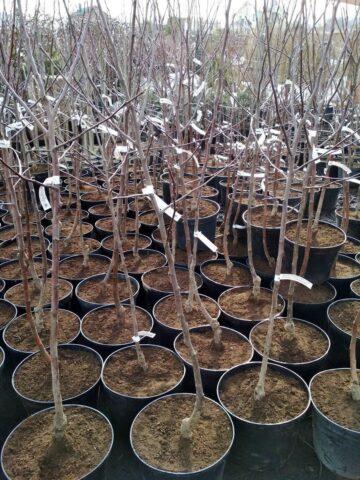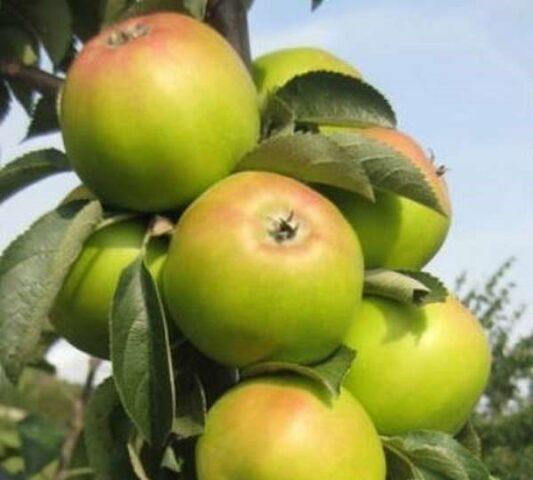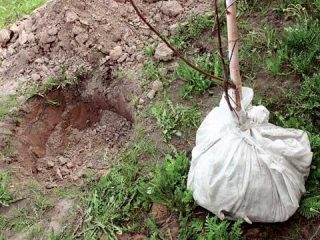Content
- 1 Frost-resistant varieties of columnar apple trees for Siberia
- 2 How to plant a columnar apple tree in spring in Siberia
- 3 Caring for a columnar apple tree in Siberia
- 4 Preparing a columnar apple tree for winter in Siberia
- 5 Diseases and pests
- 6 Conclusion
- 7 Reviews about growing columnar apple trees in Siberia
The columnar apple tree is one of the best options for Siberia, since the crop is characterized by high immunity and winter hardiness. When choosing, you should pay attention to the condition of the seedlings, and it is better to plan planting in the spring - if you do this in the fall, the plants may die.
Frost-resistant varieties of columnar apple trees for Siberia
To be able to grow a columnar apple tree in Siberia, you need to carefully select varieties. Not all varieties that grow, for example, in the middle zone, are suitable for the Siberian region. Only the most winter-hardy crops can be grown here.
Western
The climate of Western Siberia is somewhat milder than that of Eastern Siberia. In winter, there is enough precipitation here and a good snow cover is formed. The temperature, as a rule, does not drop below -32 degrees. Extreme frosts last only a few days, after which they recede.However, there are thaws, even in December, which causes temperature changes that are detrimental to many plants.
Therefore, for cultivation in Western Siberia, you should choose the following varieties of columnar apple trees:
- Medoc is one of the best varieties that grows in regions with harsh climates. The columnar tree reaches a height of 2.5 m. It belongs to the semi-dwarf varieties. It produces good, stable yields and is immune to many diseases and pests. The apples are light yellow, the structure is granular, the flesh is sunny, the taste is honey, which gives the variety its name. The average fruit weight is 200-250 g. The columnar apple tree is well suited for Siberia, since frost resistance reaches 30-35 degrees. Harvest at the end of summer.
- President is a summer variety for Western Siberia, also suitable for the middle zone, including the Moscow region. The apple tree is columnar, semi-dwarf, with a compact shape. It has high winter hardiness down to -35 degrees and is characterized by good immunity. The yield is average - up to 10 kg of fruit per tree. Their pulp is juicy, aromatic, and has a sweet taste. The fruits are light yellow, have a blush on the side, weight from 100 to 200 g.
- Ostankino is another columnar apple tree for Siberia. The tree is semi-dwarf, medium-sized, reaches a height of 2-2.5 m. Productivity and precocity are high, immunity is good. One tree yields from 6 to 16 kg, depending on care. The fruits are light green in color and have a blush. The pulp is juicy and sweetish. The ripening period occurs in mid-September. Winter hardiness up to -25 degrees.
- Among the new varieties of columnar apple trees for Siberia is Triumph. It was developed not so long ago, and in 2015 it was registered and received a patent.It is characterized by high productivity and early fruiting, and has good immunity to diseases and pests. Produces juicy and large fruits of dark red color. Ripening occurs in mid-September. The fruits are not stored for a long time - they must be used immediately for food.
Eastern
For Eastern Siberia, there are very few varieties of winter-hardy columnar apple trees that really won’t freeze and give a good harvest. These include Vasyugan and Iksha. These are suitable varieties that are highly winter hardy, so they can withstand frosts down to -40 degrees, recovering well in the spring. They also have other features:
- Vasyugan is one of the best varieties of columnar apple trees for Eastern Siberia. Tolerates extreme temperatures down to -42 degrees. It reaches a height of 2.5 to 3 m. A variety of domestic origin, early ripening - from mid to late September. The fruits are quite large and the flesh is firm. The shape of the fruit is conical, the color is striped, with a bright shade of red. The taste has a noticeable balance of sweet and sour, the flesh is quite juicy. The weight of one fruit is 150-200 g. Another advantage of the variety is good immunity to diseases and pests.
- Iksha is a variety of columnar apple tree for Eastern Siberia with very high winter hardiness, withstands down to -40 degrees. The fruits begin to form at the end of August. The collection period lasts until mid-September. This variety of apple tree for Siberia produces relatively large fruits weighing 150-180 g. The hue is orange-red, attractive, the flesh is juicy.
How to plant a columnar apple tree in spring in Siberia
When planting columnar apple trees in Siberia, it is especially important to set a time frame and also choose a location. The condition of the seedlings themselves is no less important. The basic selection rules, as well as the planting algorithm, are described below.
Selection of seedlings
It is better to buy seedlings from nurseries and other responsible suppliers with a long-standing reputation. When choosing planting material, you should pay attention to several points:
- Availability of a tag with age, description of the rootstock, variety or relevant documentation from the seller.
- The appearance of the roots - it is worth taking seedlings in pots and transferring them to the ground using the transshipment method, preserving the earthen lump as much as possible.
- 2-year-old seedlings are best suited for planting, although it is also possible to purchase annual ones, and such a plant should not have shoots.
- General healthy appearance - no mechanical damage or signs of disease.

It is recommended to purchase seedlings in pots
The day before planting, it can be soaked in a clay mash with a solution of a growth stimulator, for example, Epin or Heteroauxin.
Landing dates
It is better to plant columnar apple trees in Siberia in the spring. The standard period is autumn, but for regions with harsh winters this option is not suitable, since young seedlings can be seriously damaged and even die in frosts.
Therefore, it is best to start work in the first half of April, when the snow masses have completely melted and the temperature has become consistently positive. At the same time, short-term night frosts are not terrible, but if the soil has not yet thawed at a depth of 30-40 cm, you should wait another 2-3 weeks.
Selecting a location
Fruit trees thrive best in open, dry areas, well protected from draft winds. Buildings can be located nearby if they do not create shade, but the presence of large trees in the neighborhood is undesirable, since they will take away water and nutrients dissolved in it.
When choosing a place for planting columnar apple trees in Siberia, you should exclude lowlands, since water constantly accumulates here after rains. You also need to make sure that groundwater comes no higher than 1.5-2 m to the surface. Otherwise, the roots will suffer from excess moisture and may die.
Landing technology
Since columnar apple trees have a compact crown, they can be planted next to each other with a small interval of 1-2 m. The sequence of actions is as follows:
- Dig holes with a depth and diameter of 70-80 cm.
- Place the support in the center (you can take a peg).
- Place a layer of small stones on the bottom.
- Then plant the seedling and sprinkle it with fertile soil.
- Compact so that the root collar goes to a depth of 5-7 cm.
- Water and after a few days mulch with hay, straw or other materials.

Scheme of planting and pruning a columnar apple tree seedling
Caring for a columnar apple tree in Siberia
You can care for columnar apple trees in Siberia in much the same way as in other regions. The only exception is preparation for winter - this event must be treated especially carefully. The basic rules are described below.
Watering
Young seedlings of columnar apple trees are watered weekly; adult trees are given water 1-2 times a month. But if there is no rain at all, and a drought has set in, it is recommended to water once every 7-10 days, and sprinkle the crown in the evening.
Feeding
Columnar apple trees in Siberia are fed regularly, starting from the second season. In the spring, at the beginning of April, nitrogen compounds are added, for example, urea and ammonium nitrate. During budding and ovary formation, superphosphate and potassium salt should be given. At the beginning of autumn, the tree trunk circle can be sprinkled with wood ash. It is also recommended to alternate complex mineral fertilizing with organic matter - during the warm season, monthly watering with mullein 1:10 or bird droppings 1:20.
Trimming and shaping
Pruning of columnar apple trees in Siberia is carried out in early spring, before the buds begin to swell. Remove all frozen, weakened and old branches. At the same time, they begin to form the crown - two buds are left on the young shoots. Do not touch the apical one - it should constantly give growth. Long branches on the side are cut to form a stump to stimulate the growth of young shoots.
Preparing a columnar apple tree for winter in Siberia
Even winter-hardy varieties have a risk of freezing, so it is better to cover columnar apple trees in Siberia for the winter. The sequence of actions is as follows:
- In mid-October, after the Indian summer, the tree trunk circle is mulched with hay, straw, peat - the height of the material is from 20-30 cm. Previously fallen leaves and branches must be completely removed.
- Immediately before frost, the tree is wrapped in several layers of spandbond or other insulation.
- The tree trunk is wrapped in chain-link to protect the apple tree from rodents.
- After snowfalls, snow is added to it and compacted near the tree trunk.

Columnar apple trees take up little space and produce a good harvest
Diseases and pests
Almost all varieties for Siberia are distinguished by good immunity to various diseases and pests.However, damage to powdery mildew, gray mold, scab and other dangerous pathologies cannot be ruled out. For prevention, it is recommended to follow the watering norm, and in the spring to treat with fungicides, for example, Bordeaux mixture, “HOM”, “Abiga-Peak” and others.
Dangerous pests include spider mites, aphids, leaf rollers, apple flower beetles, codling moths and others. Trees should be periodically inspected and treated with insecticides:
- "Decis";
- "Karate";
- "Inta-Vir";
- "Aktara".
If the apple tree has entered the fruiting period, you should use folk remedies, for example, an infusion of ash, onion peels, garlic or tobacco dust.
Conclusion
The columnar apple tree for Siberia is quite suitable for both western and eastern regions. The culture is winter-hardy, does not take up much space and does not require care. If you regularly water and fertilize, the yield will be consistently high and the fruits will be quite large.
Reviews about growing columnar apple trees in Siberia














